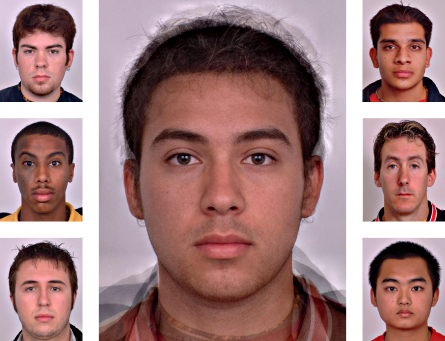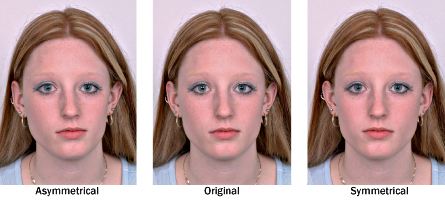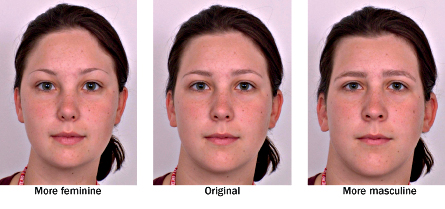Face values
Researchers are uncovering what makes a mug attractive
Share this:
- Share via email (Opens in new window) Email
- Click to share on Facebook (Opens in new window) Facebook
- Click to share on X (Opens in new window) X
- Click to share on Pinterest (Opens in new window) Pinterest
- Click to share on Reddit (Opens in new window) Reddit
- Share to Google Classroom (Opens in new window) Google Classroom
- Click to print (Opens in new window) Print
By Susan Gaidos
 |
|
Scientific research has shown that a composite face (middle) made by blending many different faces is more attractive than each of the faces used to make it.
|
| www.faceresearch.org |
You know which faces you find attractive, but why? A delicate look, a bright smile, pretty skin, big eyes — it’s hard to resist such features. It’s also hard to define them. Psychologists have been working for years to close in on the age-old question: Why do people find certain faces more attractive than others?
Scientists are now using computer graphics and other imaging techniques to answer this question. Their studies are beginning to reveal what makes a face attractive and why. And for the record, researchers have determined that beauty is not just skin deep. A recent study suggests that in males, a good-looking mug may be a sign of good genes.
Each person has his or her own opinion as to what beauty is. But scientists say there are some facial characteristics that most people from all cultures agree are attractive: averageness, symmetry and sexual dimorphism.
Averageness is a term used to describe how unusual or strange a person’s facial features are. Having a high degree of averageness can be a good thing, even if having an “average” face may sound bad.
To simulate averageness, scientists use computer-imaging techniques to combine images of many faces to create a single face. The composite, or average, face resembles a real human face. But surprisingly, the composite looks only a little like any one of the faces used. And studies done in the early 1990s showed that such “blended” faces are more attractive than the originals.
 |
|
A face can look off if one side is different from the other. Using computer technology, the face at far left has been made more asymmetrical, or unequal, than the original face in the middle. The face on the right has been made more symmetrical, so that both sides of the face are more equal.
|
| www.faceresearch.org |
Researchers also define facial beauty by how symmetrical features are: That is, how well one side of the face matches up with the other. A slight droop in one corner of the mouth or difference in the arch of an eyebrow can make a face look a bit off.
Sexually dimorphic characteristics — those that make females look more feminine (think of a stereotypical cheerleader) and males look more masculine (think of a stereotypical football player) — are also a plus the researchers found. Studies show that how feminine or masculine a face is can make the difference between a face that’s hot and one that’s not.
Obviously, you can learn a bit about someone just by looking at his or her face: gender, age and race, for example. But what about a person’s personality or health? Can your face reveal this information about you? New studies suggest the answer is maybe.
Psychologist Hanne Lie of the University of Western Australia in Perth and her colleagues recently studied how facial averageness relates to a person’s genes. The scientists focused on a cluster of 128 genes that plays an important role in the immune system, the body’s defense against illness. This cluster is known as the major histocompatibility complex, or MHC. In their study, the researchers found that males who scored high in facial attractiveness also had greater genetic diversity in their MHC. Lie and her colleagues reasoned that more average faces have a higher MHC diversity. Perhaps a more diverse MHC means a healthier, more attractive, and therefore better mate.
 |
|
Men tend to find more feminine-looking women – those with bigger eyes and lips, for example – more attractive. Here, computer technology has made a face more feminine (far left) and more masculine (far right) than the original face (middle).
|
| www.faceresearch.org |
Other studies also suggest links between attractiveness and health. A 2000 study at Brandeis University in Waltham, Mass., showed that people who scored high in symmetry and averageness were also considered to be healthier. And a 2004 study found that people with healthier-looking skin were judged to be more attractive.
Some researchers are now using brain scans to see how the human brain responds to attractiveness. In 2007, scientists used fMRI to see how people reacted to faces that were ugly, pretty or neutral. The study showed that people’s brains had strong responses to pretty faces and ugly faces, but showed less response to middle-of-the-road faces. By figuring out how the brain responds to such dramatic differences in attractiveness, researchers hope to understand how the brain reacts to more subtle, or less dramatic, differences.
In the meantime, bear in mind that your mug may be revealing more than you think. So remember to always put your best face forward.
Going Deeper:







